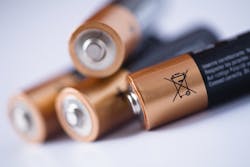New desalination technology inspired by materials in batteries
CHAMPAIGN, Ill. — Feb. 1, 2016 — Engineers at the University of Illinois are working on a new desalination technique that uses battery technology to purify salt water, according to a press release.
One common method of desalination, reverse osmosis, pushes water through a membrane that keeps out the salt — a costly and energy-intensive process, the University of Illinois said in the release. By contrast, the battery method uses electricity to draw charged salt ions out of the water.
Illinois mechanical science and engineering professor Kyle Smith and graduate student Rylan Dmello recently published details of their work in the Journal of the Electrochemical Society.
“We are developing a device that will use the materials in batteries to take salt out of water with the smallest amount of energy that we can,” Smith explained in the release. “One thing I’m excited about is that by publishing this paper, we’re introducing a new type of device to the battery community and to the desalination community.”
View the largest desalination plan in the U.S.
The researchers were reportedly inspired by sodium ion batteries, which contain salt water. Batteries have two chambers, a positive electrode and a negative electrode, with a separator in between that the ions can flow across. When the battery discharges, the sodium and chloride ions — the two elements of salt — are drawn to one chamber, leaving desalinated water in the other.
In a normal battery, the ions diffuse back when the current flows the other direction, stated the release. For desalination, the Illinois researchers had to find a way to keep the salt out of the now-pure water.
“In a conventional battery, the separator allows salt to diffuse from the positive electrode into the negative electrode,” Smith said in the release. “That limits how much salt depletion can occur. We put a membrane that blocks sodium between the two electrodes, so we could keep it out of the side that’s desalinated.”
According to the researchers, the battery approach offers several advantages over reverse osmosis. The device can be small or large, whereas reverse osmosis plants must be very large to be efficient and cost effective. Less pressure is required to pump the water, as it simply flows over the electrodes instead of being forced through a membrane. And the rate of water flowing through it can be adjusted more easily than other types of desalination technologies that require more complex plumbing.
You can find the entire release here.
